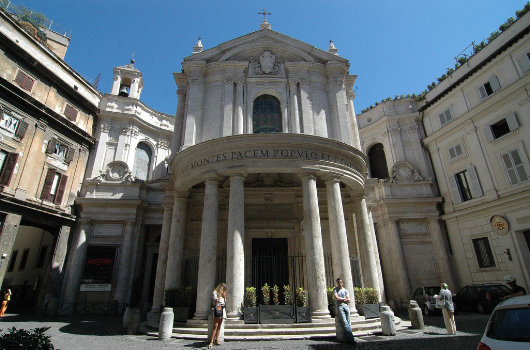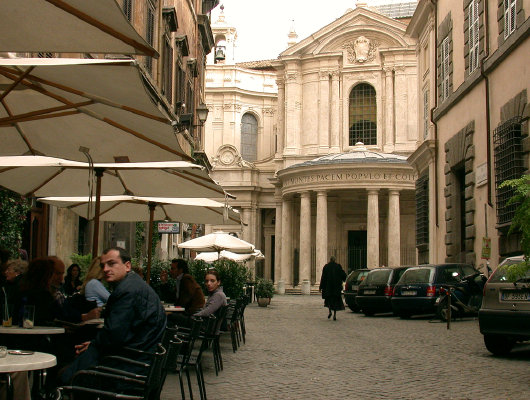Church
About Andrew Cusack
 Writer, web designer, etc.; born in New York; educated in Argentina, Scotland, and South Africa; now based in London.
Writer, web designer, etc.; born in New York; educated in Argentina, Scotland, and South Africa; now based in London. read more
News
Blogs
Reviews & Periodicals
Arts & Design
World
France
Mitteleuropa
Knickerbockers
Argentina
The Levant
Africa
Cape of Good Hope
Netherlands
Scandinavia
Québec
India
Muscovy
Germany
Academica
Fire at St. Jodard
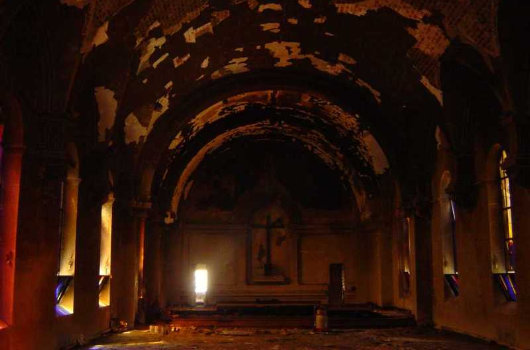
The chapel of the Community of St. Jean’s novitiate at Saint-Jodard in France was tragically consumed by an accidental fire late last month. The brothers give thanks that no one was harmed in the fire and look upon the event as “a favorable occasion to learn how to live together in the Great Hope and to redouble fraternal charity”.
Contributions can be sent to:
Prieuré Saint Joseph
42590 St Jodard
FRANCE
Ingrid Betancourt at Castel Gandolfo
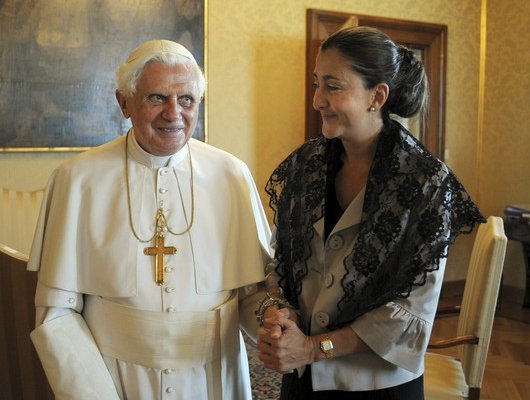
Ingrid Betancourt was welcomed by Pope Benedict XVI at the papal retreat of Castel Gandolfo this week. The Franco-Colombian politician was freed from the communist FARC guerrillas in July by a stealth operation of the Colombian Army in which not a single shot was fired. Betancourt had been held hostage for over six years in the South American jungle. After being reunited with her family, she made a pilgrimage to Lourdes to give thanks for the intercession of the Blessed Virgin in sustaining her during her capitivity.
Church music by the unchurched: Saint-Saëns
“No thoughtful Catholic will have difficulty distinguishing Mozart’s music from his Freemasonry, any more, for example, than separating Bach’s work from his Lutheranism. If we were to dismiss every human work that had been created by a sinner there might not be much left standing. I was once taken to task for leading a congregation in a ‘Protestant tune’, to which I replied, ‘Which note was Protestant?’. Let us move on.”
So begins a delightful appreciation of the sacred music of Camille Saint-Saëns written by R. J. Stove and printed in the latest issue of Oriens, an Australian publication devoted to traditional Catholic culture. It is but the first of a series discussing eminent composers who spent most of their lives outside orthodox Catholicism, but who made notable contributions to sacred music. Mr. Stove is also a contributor to The New Criterion and was kind enough to send me a copy of his article, which was both comprehensive and concise while remaining interesting throughout. More information on Oriens can be found at their website.
David Lumsden of Cushnie, 1933-2008
Garioch Pursuivant of Arms, sometime Baron of Cushnie-Lumsden, Knight of Malta, Patron of the Aboyne Highland Games

It was with great sadness that I learned this morning of the death of David Lumsden. He was an exceptionally genial and affable man, and was relied on to provide good company at many events, from balls to Sunday lunches and everything in between. But David was generous not only with his good company but with his patronage, as is attested to by the countless organizations he helped and guided. Here was a man who was generous of spirit. David’s death came very suddenly yesterday afternoon in his hotel room at the annual conference of the 1745 Association, of which he was president. Just last Sunday he had attended the traditional Mass at St. Andrew’s, Ravelston in Edinburgh, where a friend described him as “looking as hale and hearty as ever”.
David Gordon Allen d’Aldecamb Lumsden of Cushnie, sometime Baron of Cushnie-Lumsden, was born on 25 May in 1933 in Quetta, Baluchistan in the Empire of India. He was the son of Henry Gordon Strange Lumsden, a Major in the Royal Scots, of Nocton Hall, Lincolnshire and Sydney Mary, only child of Brigadier-General Charles Allen Elliot.
He was educated at Allhallows, Devon, Bedford School, and at Jesus College, Cambridge before serving in the Territorial Army with the London Scottish while working at British American Tobacco. He was a Knight of the Order of Malta, as well as of the Constantinian Order, and was Patron of the Aboyne Highland Games. David enthusiastically served as Garioch Pursuivant to the Chief of the Name and Arms of Mar (presently Margaret of Mar, the 30th Countess of Mar), one of the four surviving private officers of arms in Scotland recognised by the Court of the Lord Lyon.

Lumsden with friends, at the Aboyne Highland Games.
David co-founded the Castles of Scotland Preservation Trust and the Scottish Historic Organs Trust and was President of the Scottish Military History Society. In addition to his Magister Artium from Cambridge, he was a Fellow of the Society of Antiquaries of Scotland. He was on the council of The Admiral the Viscount Keppel Association and was one of the patrons of the famous Russian Summer Ball in London. He was Convenor of the Monarchist League of Scotland and was on the council of the Royal Stuart Society.
In the realm of sport, he was a keen shot and had rowed at Cambridge, in addition to his interest in sailing and riding.
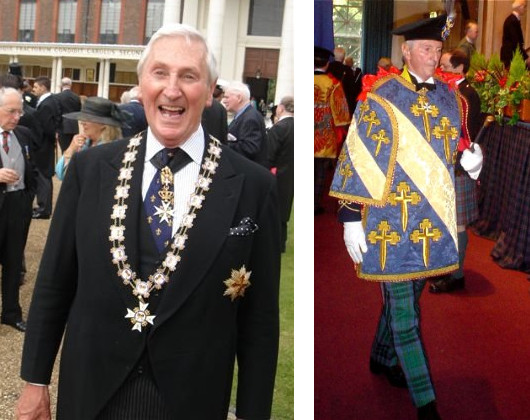
Left: Representing the Royal Stuart Society at the Henry IX commemoration at the Royal Hospital Chelsea. Right: In his capacity as Garioch Pursuivant of Arms, at the XXVIIth International Congress of Genealogical and Heraldic Sciences in 2006.
David had a passion for architecture, and especially that of his native Scotland. Returning in 1970 after a spell in Africa, he undertook the restoration of two family properties: Cushnie House, built in 1688 by Alexander Lumsden and Tillycairn Castle, built in 1540 by Matthew Lumsden. He later went on to restore Leithen Lodge at Innerleithen, an 1880s shooting lodge built in a distinctly Scottish take on the Arts & Crafts tradition. Under the auspices of the Castles of Scotland Preservation Trust, in 1994 he oversaw the restoration of Liberton Tower just south of the Royal Observatory in Edinburgh.
“David was a unique man possessed of an insatiable love of life and learning,” his friend Rafe Heydel-Mankoo said. “He will be deeply missed and fondly remembered by those fortunate enough to have met him.”
“David was at the centre of so many things, and brought together so many different people,” said Lorna Angus, the wife of Robin Angus. “He could bring life to any gathering and he made so many good things possible.”
Robin Angus, meanwhile, said that David Lumsden “personified a world of precious things — things which are imperilled, but which never seemed imperilled when he was there.”
“David no longer visibly with us is unimaginable,” Robin continued. “What his friends must now do is keep the flame, and — as he did — pass it on to others with the same generous wisdom. He was the soul of old Scotland. I hope that, in Heaven, Raeburn will make amends for what the centuries did not allow, and paint his portrait.”
While I wholeheartedly agree with Robin, it must be said that those who were blessed to know David are left with a portrait of him in our hearts and minds far greater than even the brush of Raeburn could achieve.
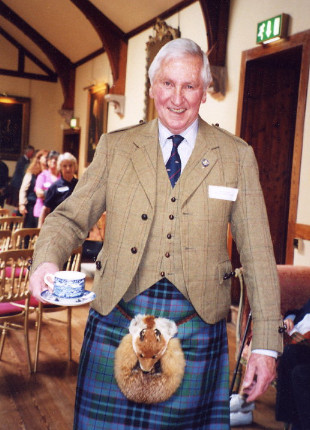
David Gordon Allen d’Aldecamb Lumsden
of Cushnie
1933–2008
“… hold fast to that which is good.”
— 1.Thess 5:21
Requiem aeternum dona eis Domine:
et lux perpetua luceat eis.
Requiescat in pace.
Santa Maria della Pace
One of my favourite churches in all of Rome is that of Santa Maria della Pace. The best approach is from the alley leading out of the northwest corner of the Piazza Navona, crossing the Via di Santa Maria dell’Anima and making sure to turn left into the smaller alleyway when the little street itself swerves north. Moving forward, the perambulator suddenly emerges into a tiny trapezoidal piazza and having continued for a few paces realizes, almost as an afterthought, that there is something over your right shoulder. There is the Church of Santa Maria della Pace.
Like so many Roman edifices the Church is the work of many centuries. A church dedicated to the Apostle Andrew once stood on the site, and it was on the foundations of that church in 1482 that work on Santa Maria della Pace commenced. Sixtus IV, praying for peace in the Italian peninsula, vowed to build a church dedicated to Our Lady of Peace, and hence the Apostle’s patronage was superseded. While Baccio Pontelli deserves the credit for the church proper, Pietro da Cortona’s splendidly theatrical façade and its enveloping piazza were commissioned Alexander VII in the 1650s.
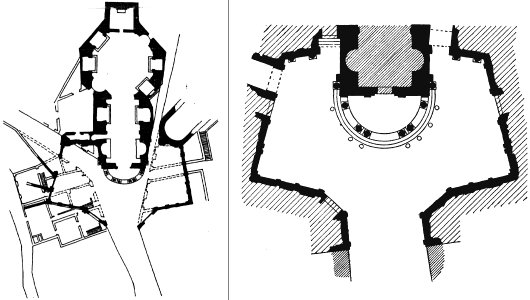
Santa Maria della Pace has a number of connections to the Chigi dynasty. The first prominent member of the Chigi family was Agostino (1465–1520), a wealthy banker and builder of the Villa Farnesina in Trastevere. Here at Santa Maria della Pace, Agostino commissioned the Capella Chigi (not to be confused with the Capella Chigi in Santa Maria del Popolo). Alexander VII himself was a Chigi, and perhaps this explains his patronage of Cortona’s façade and piazza. Among the later Chigi clan, there were a number of cardinals, some of whom were even nuncios, and more recently Ludovico Chigi Albani della Rovere was Prince & Grand Master of the Order of Malta from 1931 to 1951. Anyhow, the Chigi chapel features a fresco initiated by Raphael (and completed by his school), while the adjacent chapel includes sculptural decoration by Michelangelo.
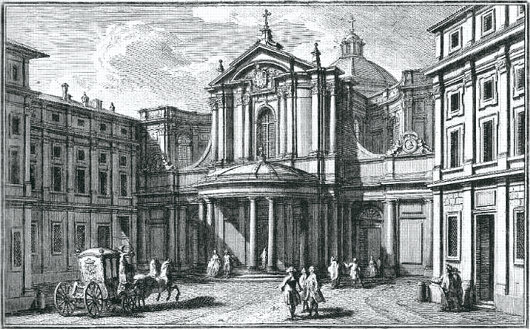
In addition to greats such as Raphael, Michelangelo, and Cortona, the cloister of the church is by none other than Bramante, and indeed was his first work in the Eternal City. Somewhat exhaustively, it doesn’t end there. Santa Maria della Pace has a high altar by Carlo Maderno, a sculpture of the Deposition by Cosimo Fancelli, two small frescoes by il Rosso Fiorentino, and another fresco by Baldassarre Peruzzi who, shall we say in kindness, was a much better architect than painter. There are further works by Maratta and Gentileschi (Orazio, that is — not Artemisia).
The Catholic Herald

First Christian de Lisle, now Jennifer Roche: at this rate within a year everyone I know will have contributed to the Catholic Herald! (And, incidentally, I did have a brief chat in the Travellers Club once with the chap who wrote the piece on the Assumption).
I might just have to take out a subscription, though an electronic one — probably the most convenient for we across the seas — is still a hefty £38: at today’s exchange rate that’s seventy good ole American smackeroons! Probably worth it, though.
Propaganda Fide

Cheers to the unknown wag who created this delightful poster, parodying the Obama “HOPE” posters.
Alexander Solzhenitsyn, 1918–2008
Russian traditionalist, Nobel laureate, feted in the West for criticism of Soviet Communism, then spurned for rejecting liberal materialism

Alexander Isayevich Solzhenitsyn, the most famous Russian writer and historian of our age, has died at eighty-nine years of age. Solzhenitsyn was the earliest to bring first-hand knowledge of the Gulag, the Soviet system of prison colonies and labour camps, to wider Western attention. For this noble task, he was awarded the Nobel Prize for Literature in 1970 and expelled from the Soviet Union four years later, returning in 1994. After the fall of the Soviet regime, he despised Boris Yeltsin’s incompetence, identifying 1998 as the low point of Russia’s recent history. “Yeltsin decreed I be honored the highest state order,” Solzhenitsyn explained. “I replied that I was unable to receive an award from a government that had led Russia into such dire straits.”
He gave cautious support to the presidency of Vladimir Putin, and was pleased that while, in his words, “Moscow is still communist”, there was a growing readiness under Putin to admit (and even broadcast on state television) the crimes and outrages of the Soviet regime.
“Putin inherited a ransacked and bewildered country, with a poor and demoralized people. And he started to do what was possible — a slow and gradual restoration. These efforts were not noticed, nor appreciated, immediately. In any case, one is hard pressed to find examples in history when steps by one country to restore its strength were met favorably by other governments.”
Influenced by his experience in exile in both Switzerland and New England, Solzhenitsyn insisted on the need for local self-government in Russia. “Today I continue to be extremely worried by the slow and inefficient development of local self-government. But it has finally started to take place. In Yeltsin’s time, local self-government was actually barred on the regulatory level, whereas the state’s ‘vertical of power’ (i.e. Putin’s centralized and top-down administration) is delegating more and more decisions to the local population. Unfortunately, this process is still not systematic in character.”
Solzhenitsyn expressed further disappointment with the new Western imperialism being waged against Russia, embodied in the 1999 War against Serbia which turned so many Russian minds against the Western powers they had previously been quite friendly to.
In a recent interview with Der Spiegel, Solzhenitsyn was asked whether he was afraid of death:
“No, I am not afraid of death any more. When I was young the early death of my father cast a shadow over me — he died at the age of 27 — and I was afraid to die before all my literary plans came true. But between 30 and 40 years of age my attitude to death became quite calm and balanced. I feel it is a natural, but no means the final, milestone of one’s existence.”
When the interviewer from Der Spiegel wished him many more years of “creative life”, Solzhenitsyn calmly responded “No, no. Don’t. It’s enough.”
Revolution’s loss is counter-revolution’s gain
 As Christian de Lisle reports in the latest Catholic Herald, Chase Hilgenbrinck, the 26-year-old defense player for the New England Revolution, is leaving the world of professional soccer to pursue a vocation to the priesthood. “Playing professional soccer has been my passion for a long time,” Hilgenbrinck told the press, “and I feel blessed to have successfully lived out this dream. My passion now is to do the will of God, which is wanting only what He wants for me. Though I will miss the game of soccer, I know that I am moving on to something much greater.”
As Christian de Lisle reports in the latest Catholic Herald, Chase Hilgenbrinck, the 26-year-old defense player for the New England Revolution, is leaving the world of professional soccer to pursue a vocation to the priesthood. “Playing professional soccer has been my passion for a long time,” Hilgenbrinck told the press, “and I feel blessed to have successfully lived out this dream. My passion now is to do the will of God, which is wanting only what He wants for me. Though I will miss the game of soccer, I know that I am moving on to something much greater.”
Earlier, Hilgenbrinck, who had a four-year career in Chile before returning this year to play professionally in the States, considered waiting until the end of his soccer-playing days. “Delayed obedience is disobedience,” he told the Associated Press. “We are all called to do something. I feel like my specific call is to the priesthood. So, no, it was not possible to continue with soccer. It’s absolutely inevitable.”
Hilgenbrinck will enter the seminary at Mount St. Mary’s University, one of the oldest Catholic institutions in the United States.
The Pope at Government House

Pope Benedict XVI reviews the guard after being received by Maj. Gen. Jeffery, the Governor-General of Australia.
The Holy Saints of Russia
Russia remembers the murdered Tsar St. Nicholas II & his family

Christians in Russia yesterday solemnly remembered the brutal killing of the country’s Imperial Family by the Bolshevik revolutionaries 90 years earlier. Tsar Nicholas II, the Tsarina Alexandra, their daughters the Grand Duchesses Olga, Tatiana, Maria, and Anastasia, and the Tsarevich Alexei have all been added to the canon of saints of the Russian Orthodox Church. The Imperial Family were first officially recognized as saints by the Russian Orthodox Church outside the Soviet Union in 1981, and the Moscow patriarchate extended the same recognition in 2000.
Ingrid Betancourt Goes to Lourdes
Ex-hostage gives thanks at Marian shrine during its 150th year

Ingrid Betancourt has travelled to the Shrine of the Blessed Virgin at Lourdes in France to give thanks for her liberation from years of captivity as a hostage of the FARC. Alongside her mother, son, and daughter, Ms. Betancourt also offered prayers on behalf of those prisoners who are still held hostage by the FARC guerrillas.
Saskatoon Cathedral
Matthew Alderman’s hypothetical counter-proposal

Matthew Alderman has designed a hypothetical counter-proposal for the new Catholic cathedral in Saskatoon, Saskatchewan which is infinitely more beautiful than the ugly modernist thingamajig that the diocese is actually building. Matt elaborates upon the problematic nature of the modernist design here and here.
Reunited

Ingrid Betancourt sees her children in person for the first time in over six years.
Ingrid Betancourt has described her liberation as a “miracle from the Virgin Mary” and has revealed how prayer kept her going during her six years and five months in captivity, admitting that the temptation of suicide was ever-present.
President Uribe gives credit where credit is due:
Do continue to keep up your prayers for Colombia, a land which is still plagued with many evils, though simultaneously bestowed with many graces.
Catholics & the Military
Back in May, Michael J. Iafrate, a fellow Catholic who is a native of the great state of West Virginia and is now studying in the fair dominion of Canada, raised the subject of the obnoxious proselytism by Evangelical Protestants in our nation’s military on his very interesting site, catholicanarchy.org.
Mr. Iafrate commented:
To be fair, the early Christians were forbidden to serve in the Roman military because it typically involved making occasional sacrifices to pagan gods, not because of an objection to the military service itself. Indeed, we have early saints such as St. Maurice (pictured at left in a painting by Lucas Cranach the Elder), a Catholic African who served in the Roman military, and of course St. Alban as well.
 The story of Spc. Hall that Mr. Iafrate brings our attention to is not really about the “problem” of Christians in the military but rather one of the problems of Evangelical Protestant Christianity in general, exhibited in the specific situation of the military in particular. Many Evangelical Protestants know no form of evangelization other than the full frontal attack. I’m sure we’ve all had our fair share of run-ins with the “HaveyouacceptedJesusChristasyourLordandSavior?” type.
The story of Spc. Hall that Mr. Iafrate brings our attention to is not really about the “problem” of Christians in the military but rather one of the problems of Evangelical Protestant Christianity in general, exhibited in the specific situation of the military in particular. Many Evangelical Protestants know no form of evangelization other than the full frontal attack. I’m sure we’ve all had our fair share of run-ins with the “HaveyouacceptedJesusChristasyourLordandSavior?” type.
Catholics, meanwhile, are a bit lackluster in the realm in-your-face evangelization (and I’m not sure this is regrettable because I think a great many souls turn away from Christianity because Evangelical Protestantism is the only form they are familiar with). Why not, we would say, try 1) setting an example by leading a virtuous Christian life, 2) praying for those you hope God will convert, or 3) fasting, making little sacrifices, or offering up little sufferings?
Historically, we Catholics have also preferred evangelizing through institutions, such as monarchies or universities or hospitals and other works of charity and mercy. Many a tribe and nation were converted by zealous souls going and converting their king or ruler first. Modern-day types will probably decry this as “elitist” — the Jesuit Fr. Reese, of America magazine notoriety, scandalously suggested that we shouldn’t be proud of an Emperor-Saint like Charles of Austria because it’s “elitist” and “not the kind of message we should be sending”. While Fr. Reese might be keen on abandoning the souls of the powerful and having godless un-Christian people running the world, I think most Catholics would prefer holy people to be in positions of power, and for people in positions of power to be holy.
I, for one, wish that traditional apostolic Christians (i.e. Catholics & Orthodox) would serve in the military in droves. I would feel much more comfortable were our armed forces heavily dominated by Catholics and Orthodox Christians than merely left to atheists, evangelical Christians, and run-of-the-mill materialists.
The fact that Spain ‘s military was so Catholic-dominated in the 1930’s saved the country from the Communists. (Though, admittedly, the Spanish Communists were so horrendous that the military junta even had a unbelieving Freemason among its members!). At the end of the Spanish Civil War, Franco laid his sword upon the altar of the Church of St. Barbara in Madrid, praying “Lord, benevolently accept the effort of this people, which was always Thine, which, with me and in Thy name, has vanquished with heroism the enemy of Truth in this century.” He then vowed never again to take up that sword unless Spain herself was threatened, and kept that vow til his death.
And then one thinks of anti-Nazi officers in the German army like Stauffenberg and Boeselager. One of the most faithful defenders of the (non-Catholic) Hawaiian monarchy against its American capitalist foes was a Catholic officer in the Hawaiian army. I certainly find it comforting that nearly half the officer corps of the British Army are Catholic.
UPDATE: Mr. Iafrate responds, both below and here.
“The Bridge of San Luis Rey”

New Spain never looked so good as in the 2004 film of Thornton Wilder’s novel The Bridge of San Luis Rey. This is no doubt partly because it wasn’t filmed in New Spain but in Old Spain (specifically in Toledo and Málaga).

Professor Haldane in the Catholic Herald

The Catholic Herald talks to Professor Haldane about the Church’s failure to halt the revolting HFE bill that recently passed (the one authorizing animal-human hybrids and the creation of human “saviour siblings” in labs for organ harvesting) and they have a nice picture of the Good Professor in his sitting room at St Andrews. Prof. & Mrs. Haldane were always very welcoming to students and had a whole bunch of us over a number of times. As I wrote before:
He has a library to be envied as well.
In my very first year at St Andrews, I had the privilege of shaking the hand of none other than Mr. James Macmillan (Greatest Living Scotsman!) at Professor Haldane’s. Certainly one to remember.
Christ at the heart of Quebec
Quebec, la belle province, was once a land as Christ-haunted as Flannery O’Connor’s American South, with classical parish churches at the heart of towns and cities, and crucifixes in classrooms, courtrooms, and most prominently looking down from on high above the Speaker’s Chair in the Parliament of Quebec. (Alfred Hitchcock’s “I Confess” superbly depicts Quebec’s Catholic society in the 1950s). While the so-called “Quiet Revolution” of the 1960s created an altogether more secularized modern society, robbing the Quebecois of their cultural and religious heritage, the crucifix in parliament remained, most recently challenged by the Bouchard-Taylor report, released this week.
Quebec has undergone an identity crisis concurrent with its latest wave of immigration, most of these immigrants hailing from Africa and the Middle East. Whereas there is no dominant ethnic group or ethnic-based identity in English-speaking Canada (descendants of Britons comprising 34% of the population), in Quebec 77% of the population are ethnic French-Canadians. Of those Quebecois whose primary language is French, 71.7% claim that their society is “overly tolerant” with regard to immigration (a figure that drops to 35.2% for those whose primary language is not French).
The specially-commissioned Bouchard-Taylor report makes a number of recommendations of how to better integrate the newer immigrants, and repeatedly calls for the removal of the crucifix from parliament as well as an end to all public prayers at government functions.
Happily, the National Assembly of Quebec has unanimously passed a resolution stating that the crucifix will stay where it is. The motion was proposed by the Premier of Quebec, Mr. Jean Charest, and Mr. Charest’s Liberals were joined by the official opposition, the Action democratique de Quebec, and the separatist Parti Quebecois.
“We cannot erase our history,” Premier Charest said. “The crucifix is about 350 years of history in Quebec that none of us are ever going to erase, and of a very strong presence, in particular of the Catholic Church. And that’s our reality. And those who come to Quebec are joining a society where that history is now something that is part of our story.”
The Bouchard-Taylor report, however, draws some altogether different conclusions. “Catholicism has left an indelible mark on Québec’s history,” the report concedes. “Traces of it are all around us. Under the principle of the neutrality of the State, religious displays linked to the functioning of public institutions should be abandoned. Thus, we do not believe that the crucifix in the National Assembly and the prayers that precede municipal council meetings have their place in a secular State. In both instances, public institutions are associated with a single religious affiliation rather than addressing themselves to all citizens.”
“That being the case,” the report continues, mixing common sense with liberal cant, “it would be absurd to want to extend this rule of neutrality to all historic signs that no longer fulfil an obvious religious function, e.g. the cross on Mont-Royal or the crosses on old buildings converted to secular uses. The same is true of Québec toponymy, which is largely inspired by the calendar of the saints. Quebecers’ common sense will surely prevail in this respect.”
(Rather absurdly, the Societé Saint-Jean-Baptiste de Montréal, a cultural nationalist group named after the province’s patron, St. John the Baptist, has stated in response to the report that it wholly supports the concept of a secular Quebec and that prayer has no place in civic forums.)
It would be more heartening if the National Assembly’s refusal to remove the crucifix were evidence of a renewed commitment to keep Christianity as the governing principle of Quebec society, but sadly Our Lord has been reduced to a cultural relic of great importance. However, the mere fact that it is being left alone, despite many challenges, gives us hope. So does the surprising success of Quebec’s ADQ party, which came from almost nowhere to within a few breaths of actually forming the government at the last provincial election.
Should the ADQistes capture the premiership at the next election they will have succeeded in bringing moderate conservative government to one of the New World’s most secularized bailiwicks. Conservatives, having once written off the province entirely, should definitely keep Quebec on our list of “ones to watch”.
[First published in Taki’s Magazine]
Chartres 2008

It’s that time of year again. This Pentecost weekend, 10,000 traditional Catholic pilgrims walked en masse over the space of three days from Paris to Chartres. The annual “Notre Dame de Chrétienté” (Our Lady of Christendom) pilgrimage is mostly French but with a healthy spattering of Britons, Americans, and others to add to their happy numbers. It begins in the Cathedral of Notre-Dame de Paris on the vigil of Pentecost and ends up at the Cathedral of Notre-Dame de Chartres on Pentecost Monday, which is traditionally a day off in France. Traditional Masses are said each day (with confessions heard beforehand) along the route.
Search
Instagram: @andcusack
Click here for my Instagram photos.Most Recent Posts
- A Christmas Gift from the Governor December 24, 2024
- Oude Kerk, Amsterdam December 24, 2024
- Gellner’s Prague December 19, 2024
- Monsieur Bayrou December 18, 2024
- Dempsey Heiner, Art Critic December 17, 2024
Most Recent Comments
Book Wishlist
Monthly Archives
Categories

